Parametric Analysis and Multi-Objective Optimization of Pentamode Metamaterial
Abstract
1. Introduction
2. Locally Resonant Double-Cone PMs
2.1. The Formation Mechanism of Bandgap
2.2. The Regulation Method of Bandgap
3. Modeling Description
3.1. Geometrical Configuration
3.2. Finite Element Model
4. The Bandgap Properties of PMs with Various Unit Cell Arrangements
4.1. The Indicators of Bandgap Properties
4.2. The Bandgap Properties of PMHs
4.3. The Bandgap Properties of PMS and PMT
4.4. Comparison of the Bandgap Properties of PMs with Distinct Unit Cell Arrangements
5. The Bandgap Properties of PM with Different Material and Geometry Parameters
5.1. The Bandgap Properties of PMH with Various Material Parameters
5.1.1. The Bandgap Properties of PMH with Different Density
5.1.2. The Bandgap Properties of PMH with Different Poisson’s Ratio
5.1.3. The Bandgap Properties of PMH with Different Young’s Modulus
5.2. The Bandgap Properties of PMH with Different Geometry Parameters
5.2.1. The Bandgap Properties of PMH with Different Double-Cone Width
5.2.2. The Bandgap Properties of PMH with Different Node Radius
6. Discussion
6.1. The Effects of Unit Cell Arrangements on Bandgap Properties
6.2. The Effects of Component Material on Bandgap Properties
6.3. The Effects of Geometry Parameter on Bandgap Properties
7. Optimization Methodology
7.1. Definition of Optimization Problem
7.2. The overall Process of Optimization
7.3. The Construction of Kriging Model
7.4. Optimization Results
8. Conclusions
- The unit cell arrangement has a significant effect on bandgap properties. Increasing the double-cone array number from three to four to six gradually moves the PBG of PM to the high-frequency region. Meanwhile, its bandwidth rises by about 3.8 and 1.7 times, respectively. Another interesting finding is that the PMS loses SPBG characteristics when its double-cone array number increases from three to four.
- The density of double-cone region as well as Poisson’s ratio and Young’s modulus of node regions have an important influence on bandgap properties. The relationship between the PBG and SPBG of PMT and the double-cone region density is that the former shifts to the low-frequency region as the latter increases. However, the reverse is the relationship between the PBG and SPBG of PMT and Young’s modulus of node region. The bandwidth of PBG descends with the increase of Poisson’s ratio in node region.
- The double-cone width has a momentous effect on bandgap properties, while the influence of node radius on bandgap properties is slight. With the increase of double-cone width, the PBG moves to the low-frequency region, and its bandwidth is reduced. At the same time, the SPBG shifts to the high-frequency region.
- The bandgap properties of optimized PMT are improved compared to the initial PMT; in other words, the bandwidths of PBG and total bandgap are increased by nearly 2.2 and 0.27 times, respectively. However, the SPBG is narrowed by about 0.51 times. The research provides a systematic understanding for developing PM with excellent bandgap properties.
Author Contributions
Funding
Institutional Review Board Statement
Informed Consent Statement
Data Availability Statement
Conflicts of Interest
References
- Kadic, M.; Bueckmann, T.; Stenger, N.; Thiel, M.; Wegener, M. On the practicability of pentamode mechanical metamaterials. Appl. Phys. Lett. 2012, 100, 191901. [Google Scholar] [CrossRef]
- Xiao, S.; Ma, G.; Li, Y.; Yang, Z.; Sheng, P. Active control of membrane-type acoustic metamaterial by electric field. Appl. Phys. Lett. 2015, 106, 091904. [Google Scholar] [CrossRef]
- Barchiesi, E.; Spagnuolo, M.; Placidi, L. Mechanical metamaterials: A state of the art. Math. Mech. Solids 2019, 24, 212–234. [Google Scholar] [CrossRef]
- Kadic, M.; Bueckmann, T.; Schittny, R.; Wegener, M. On anisotropic versions of three-dimensional pentamode metamaterials. New J. Phys. 2013, 15, 023029. [Google Scholar] [CrossRef]
- Cai, C.; Guo, R.; Wang, X.; Sun, F.; Wang, Z.; Xu, Z. Effect of anisotropy on phononic band structure and figure of merit of pentamode metamaterials. J. Appl. Phys. 2020, 127, 124903. [Google Scholar] [CrossRef]
- Zhao, A.; Zhao, Z.; Zhang, X.; Cai, X.; Wang, L.; Wu, T.; Chen, H. Design and experimental verification of a water-like pentamode material. Appl. Phys. Lett. 2017, 110, 011907. [Google Scholar] [CrossRef]
- Quadrelli, D.E.; Cazzulani, G.; La Riviera, S.; Braghin, F. Acoustic scattering reduction of elliptical targets via pentamode near-cloaking based on transformation acoustics in elliptic coordinates. J. Sound Vib. 2021, 512, 116396. [Google Scholar] [CrossRef]
- Wu, L.; Wang, Y.; Chuang, K.; Wu, F.; Wang, Q.; Lin, W.; Jiang, H. A brief review of dynamic mechanical metamaterials for mechanical energy manipulation. Mater. Today 2021, 44, 168–193. [Google Scholar] [CrossRef]
- Casablanca, O.; Ventura, G.; Garescì, F.; Azzerboni, B.; Chiaia, B.; Chiappini, M.; Finocchio, G. Seismic isolation of buildings using composite foundations based on metamaterials. J. Appl. Phys. 2018, 123, 174903. [Google Scholar] [CrossRef]
- Milton, G.W.; Cherkaev, A.V. Which Elasticity Tensors are Realizable? J. Eng. Mater. Technol. 1995, 117, 483–493. [Google Scholar] [CrossRef]
- Fraternali, F.; Amendola, A.; Benzoni, G. Innovative Seismic Isolation Devices Based on Lattice Materials: A Review. Ing. Sismica 2018, 35, 93–113. [Google Scholar]
- Mohammadi, K.; Movahhedy, M.R.; Shishkovsky, I.; Hedayati, R. Hybrid anisotropic pentamode mechanical metamaterial produced by additive manufacturing technique. Appl. Phys. Lett. 2020, 117, 061901. [Google Scholar] [CrossRef]
- Cushing, C.W.; Kelsten, M.J.; Su, X.; Wilson, P.S.; Haberman, M.R.; Norris, A.N. Design and characterization of a three-dimensional anisotropic additively manufactured pentamode materiala). J. Acoust. Soc. Am. 2022, 151, 168–179. [Google Scholar] [CrossRef] [PubMed]
- Reid, A.; Marshall, M.; Kabra, S.; Minniti, T.; Kockelmann, W.; Connolley, T.; James, A.; Marrow, T.J.; Mostafavi, M. Application of neutron imaging to detect and quantify fatigue cracking. Int. J. Mech. Sci. 2019, 159, 182–194. [Google Scholar] [CrossRef]
- Norris, A.N. Acoustic cloaking theory. Proc. R. Soc. A-Math. Phys. Eng. Sci. 2008, 464, 2411–2434. [Google Scholar] [CrossRef]
- Li, Q.; Wu, K.; Zhang, M. Theoretical study of two-dimensional pentamode metamaterials with arbitrary primitive cells. Optoelectron. Adv. Mater.-Rapid Commun. 2022, 16, 380–387. [Google Scholar]
- Layman, C.N.; Naify, C.J.; Martin, T.P.; Calvo, D.C.; Orris, G.J. Highly Anisotropic Elements for Acoustic Pentamode Applications. Phys. Rev. Lett. 2013, 111, 024302. [Google Scholar] [CrossRef]
- Aravantinos-Zafiris, N.; Sigalas, M.M.; Economou, E.N. Elastodynamic behavior of the three dimensional layer-by-layer metamaterial structure. J. Appl. Phys. 2014, 116, 133503. [Google Scholar] [CrossRef]
- Liu, Y.; Li, Y.-F.; Liu, X.-Z. Manipulation of acoustic wavefront by transmissive metasurface based on pentamode metamaterials. Chin. Phys. B 2019, 28, 024301. [Google Scholar] [CrossRef]
- Sun, Z.; Jia, H.; Chen, Y.; Wang, Z.; Yang, J. Design of an underwater acoustic bend by pentamode metafluid. J. Acoust. Soc. Am. 2018, 143, 1029–1034. [Google Scholar] [CrossRef] [PubMed]
- Oudich, M.; Gerard, N.J.R.K.; Deng, Y.; Jing, Y. Tailoring Structure-Borne Sound through Bandgap Engineering in Phononic Crystals and Metamaterials: A Comprehensive Review. Adv. Funct. Mater. 2022, 33, 2206309. [Google Scholar] [CrossRef]
- Bueckmann, T.; Thiel, M.; Kadic, M.; Schittny, R.; Wegener, M. An elasto-mechanical unfeelability cloak made of pentamode metamaterials. Nat. Commun. 2014, 5, 4130. [Google Scholar] [CrossRef]
- Quadrelli, D.E.; Casieri, M.A.; Cazzulani, G.; La Riviera, S.; Braghin, F. Experimental validation of a broadband pentamode elliptical-shaped cloak for underwater acoustics. Extrem. Mech. Lett. 2021, 49, 101526. [Google Scholar] [CrossRef]
- Kushwaha, M.S.; Halevi, P.; Dobrzynski, L.; Djafari-Rouhani, B. Acoustic band structure of periodic elastic composites. Phys. Rev. Lett. 1993, 71, 2022–2025. [Google Scholar] [CrossRef]
- Yuan, L.; Huang, X.-Y.; Liu, Z.-Y.; Zhang, F.; Zhu, X.-L.; Yu, J.-Y.; Ji, X.; Xu, Y.-P.; Li, G.; Li, C.; et al. A single mutation in the prM protein of Zika virus contributes to fetal microcephaly. Science 2017, 358, 933–936. [Google Scholar] [CrossRef]
- Wu, F.G.; Hou, Z.L.; Liu, Z.Y.; Liu, Y.Y. Point defect states in two-dimensional phononic crystals. Phys. Lett. A 2001, 292, 198–202. [Google Scholar] [CrossRef]
- Hou, Z.L.; Wu, F.G.; Liu, Y.Y. Acoustic wave propagating in one-dimensional Fibonacci binary composite systems. Phys. B-Condens. Matter 2004, 344, 391–397. [Google Scholar] [CrossRef]
- Wang, Z.; Chu, Y.; Cai, C.; Liu, G.; Wang, M.R. Composite pentamode metamaterials with low frequency locally resonant characteristics. J. Appl. Phys. 2017, 122, 025114. [Google Scholar] [CrossRef]
- Sheeja, K.L.; Sahu, P.K.; Behera, S.K.; Dakhli, N. Compact Pentamode, Tri-band Metamaterial Antenna for Wireless Applications. In Proceedings of the IEEE International Symposium on Antennas and Propagation, Chicago, IL, USA, 8–14 July 2012. [Google Scholar]
- Smith, J.D. Application of the method of asymptotic homogenization to an acoustic metafluid. Proc. R. Soc. A-Math. Phys. Eng. Sci. 2011, 467, 3318–3331. [Google Scholar] [CrossRef]
- Liu, Z.Y.; Zhang, X.X.; Mao, Y.W.; Zhu, Y.Y.; Yang, Z.Y.; Chan, C.T.; Sheng, P. Locally resonant sonic materials. Science 2000, 289, 1734–1736. [Google Scholar] [CrossRef]
- Huang, Y.; Zhang, X. Pentamode metamaterials with ultra-low-frequency single-mode band gap based on constituent materials. J. Phys. -Condens. Matter 2021, 33, 185703. [Google Scholar] [CrossRef] [PubMed]
- Cai, C.; Han, C.; Wu, J.; Wang, Z.; Zhang, Q. Tuning method of phononic band gaps of locally resonant pentamode metamaterials. J. Phys. D-Appl. Phys. 2019, 52, 045601. [Google Scholar] [CrossRef]
- Cai, C.; Wang, X.; Wang, Q.; Li, M.; He, G.; Wang, Z.; Qin, Y. Design and optimization of three-dimensional composite multilayer cylindrical pentamode metamaterials for controlling low frequency acoustic waves. Sci. Rep. 2022, 12, 5594. [Google Scholar] [CrossRef] [PubMed]
- Cai, C.-X.; Chen, S.-G.; Wang, X.-M.; Liang, J.-Y.; Wang, Z.-H. Phononic band structure and figure of merit of three-dimensional anisotropic asymmetric double-cone pentamode metamaterials. Acta Phys. Sin. 2020, 69, 364. [Google Scholar] [CrossRef]
- Huang, Y.; Zhang, X.; Zhang, L.; Cai, C. Theoretical verification of three-dimensional manufacturable pentamode metamaterial microstructure. J. Phys.-Condens. Matter 2021, 33, 485702. [Google Scholar] [CrossRef] [PubMed]
- Krushynska, A.O.; Galich, P.; Bosia, F.; Pugno, N.M.; Rudykh, S. Hybrid metamaterials combining pentamode lattices and phononic plates. Appl. Phys. Lett. 2018, 113, 201901. [Google Scholar] [CrossRef]
- Kumar, B.; Banerjee, A.; Manna, B. Effect of finite mass on phononic band structure of face centered pentamodal lattice. Mech. Res. Commun. 2022, 124, 103933. [Google Scholar] [CrossRef]
- Scandrett, C.L.; Boisvert, J.E.; Howarth, T.R. Broadband optimization of a pentamode-layered spherical acoustic waveguide. Wave Motion 2011, 48, 505–514. [Google Scholar] [CrossRef]
- Li, Q.; Zhang, M.Q. Composite hexagonal pentamode acoustic metamaterials with tailored properties. J. Phys.-Condens. Matter 2020, 32, 475701. [Google Scholar] [CrossRef] [PubMed]
- Wang, G.; Jin, L.; Zhang, L.; Xu, Z. Phonon band structures of the three dimensional latticed pentamode metamaterials. Aip Adv. 2017, 7, 025309. [Google Scholar] [CrossRef]
- Cai, X.; Wang, L.; Zhao, Z.G.; Zhao, A.G.; Zhang, X.D.; Wu, T.; Chen, H. The mechanical and acoustic properties of two-dimensional pentamode metamaterials with different structural parameters. Appl. Phys. Lett. 2016, 109, 131904. [Google Scholar] [CrossRef]
- Cai, C.X.; Wang, Z.H.; Li, Q.W.; Xu, Z.; Tian, X.G. Pentamode metamaterials with asymmetric double-cone elements. J. Phys. D-Appl. Phys. 2015, 48, 175103. [Google Scholar] [CrossRef]
- Liu, L.; Hussein, M.I. Wave Motion in Periodic Flexural Beams and Characterization of the Transition Between Bragg Scattering and Local Resonance. J. Appl. Mech.-Trans. Asme 2012, 79, 011003. [Google Scholar] [CrossRef]
- Lu, Z.-Q.; Zhao, L.; Ding, H.; Chen, L.-Q. A dual-functional metamaterial for integrated vibration isolation and energy harvesting. J. Sound Vib. 2021, 509, 116251. [Google Scholar] [CrossRef]
- Quan, N.; Yin, J.; Ng, S.H.; Lee, L.H. Simulation optimization via kriging: A sequential search using expected improvement with computing budget constraints. Iie Trans. 2013, 45, 763–780. [Google Scholar] [CrossRef]
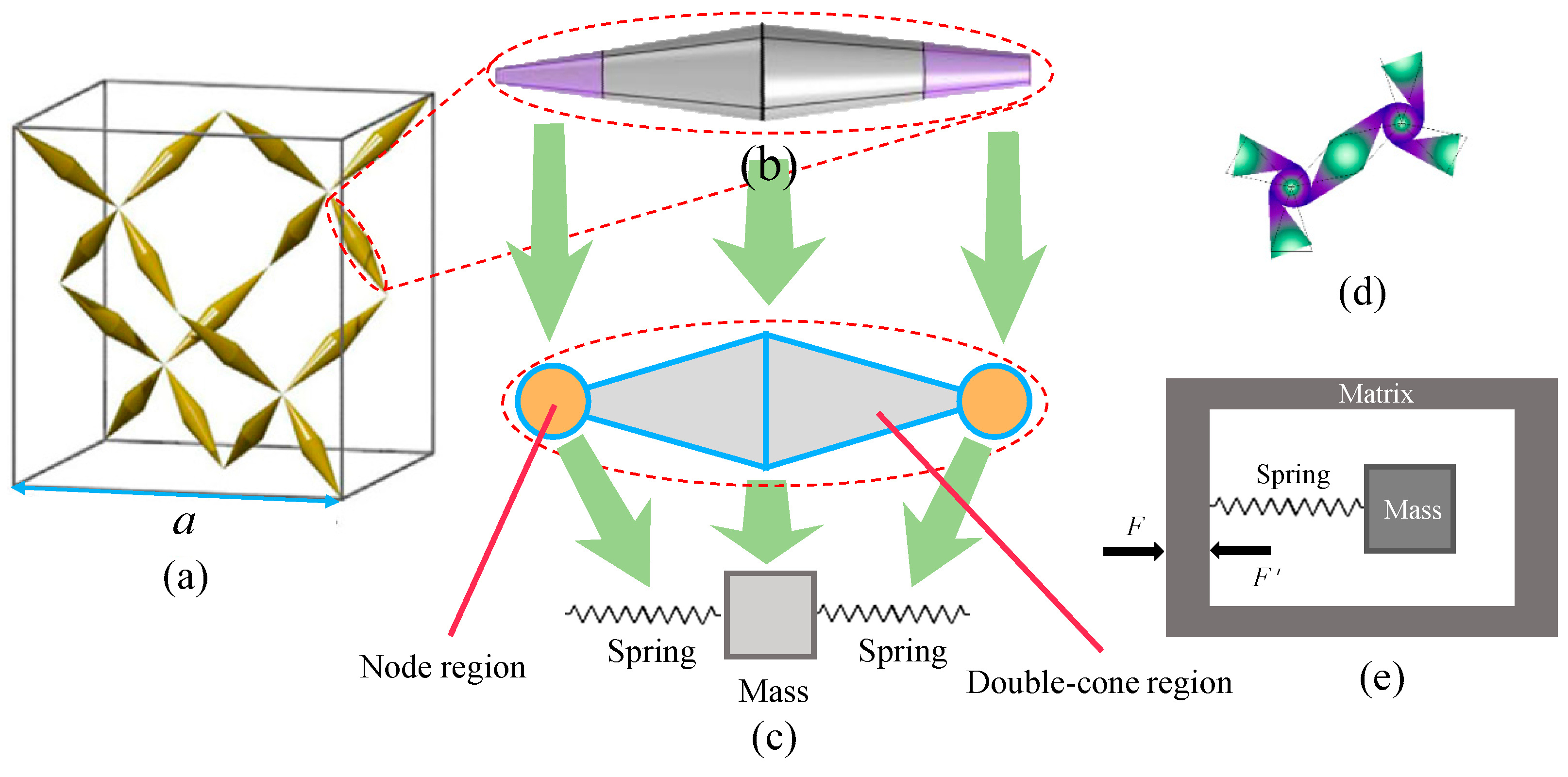



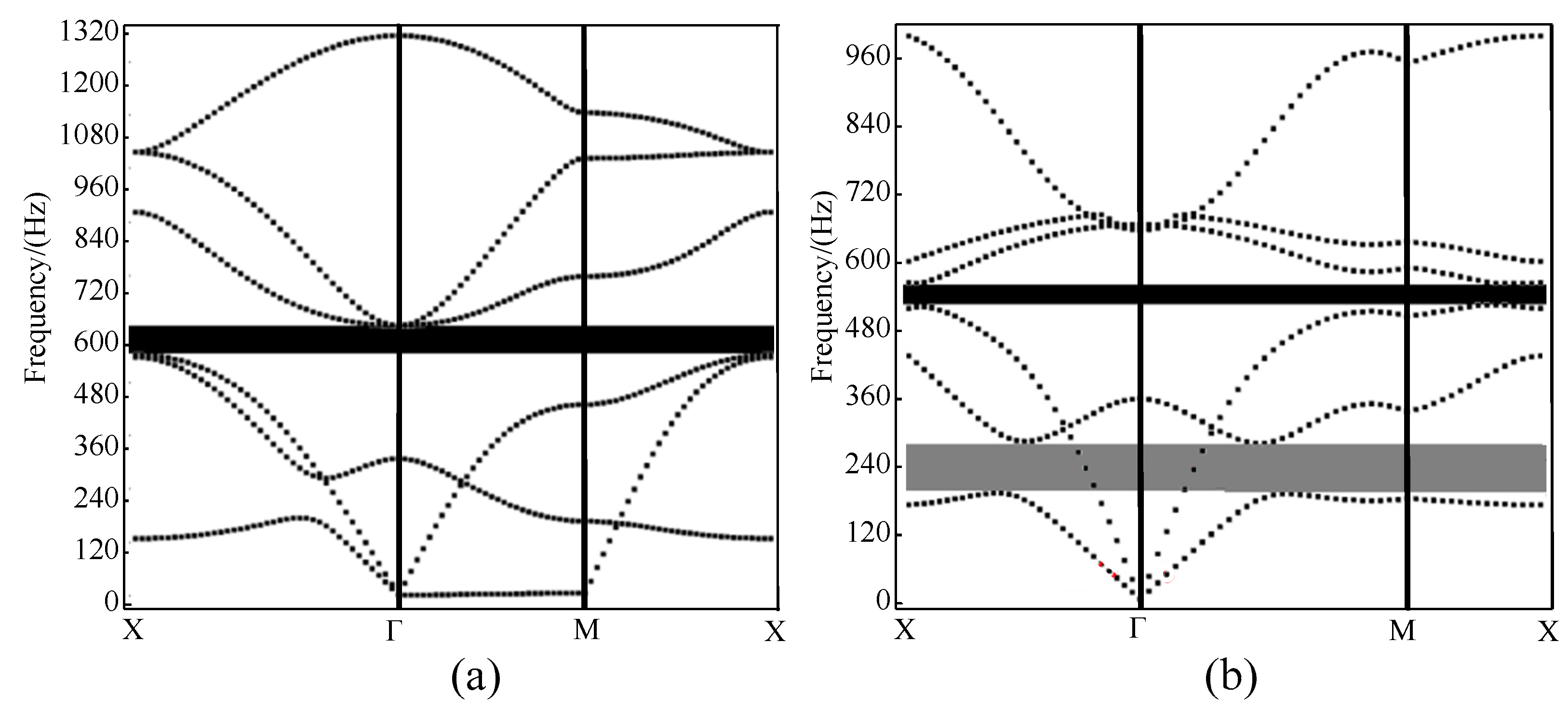
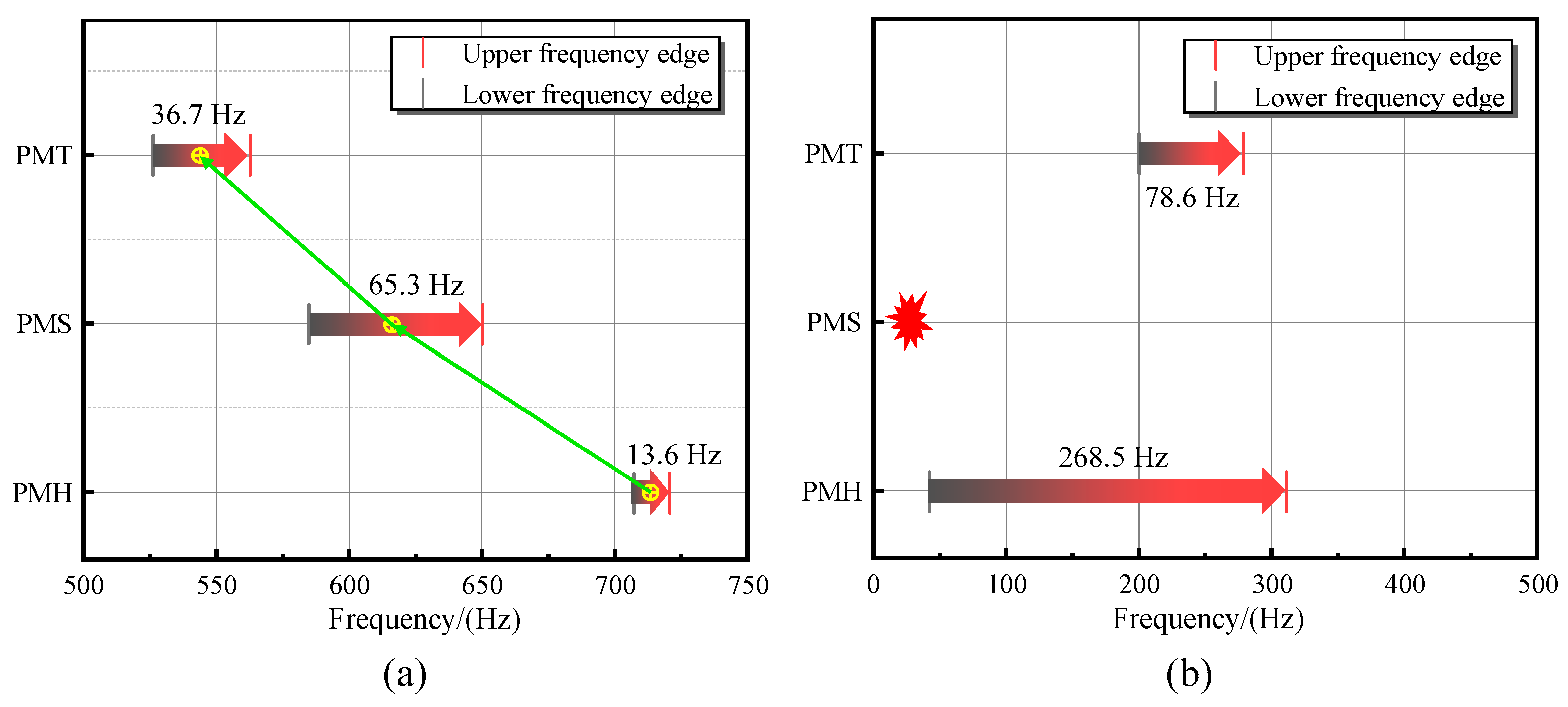

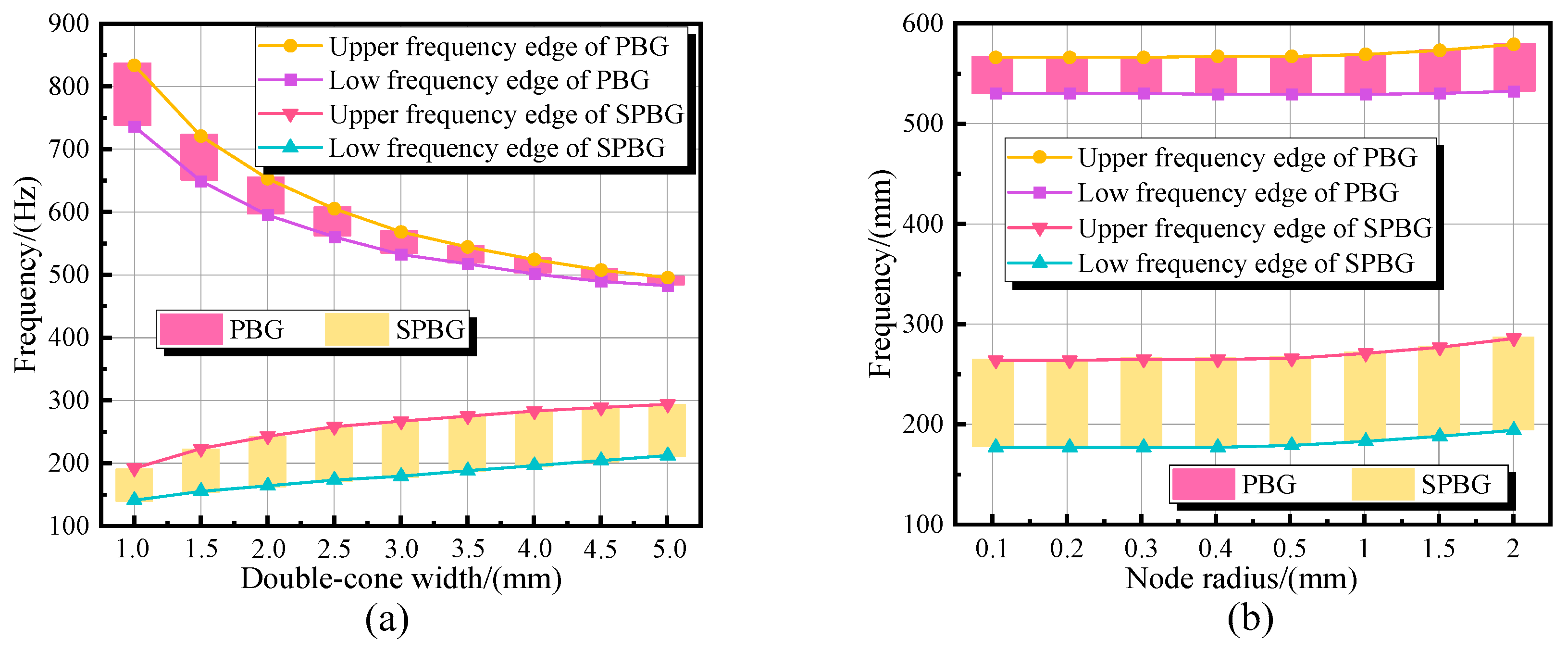

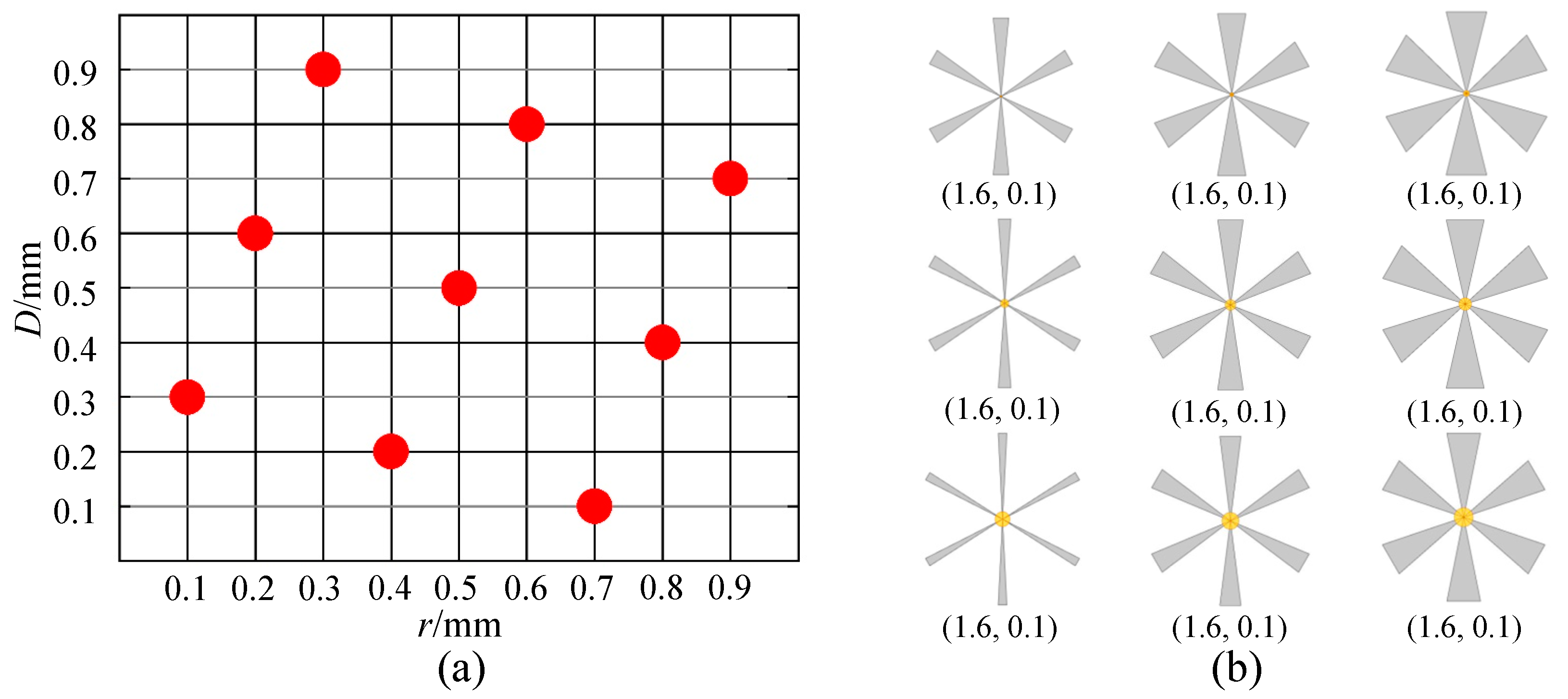
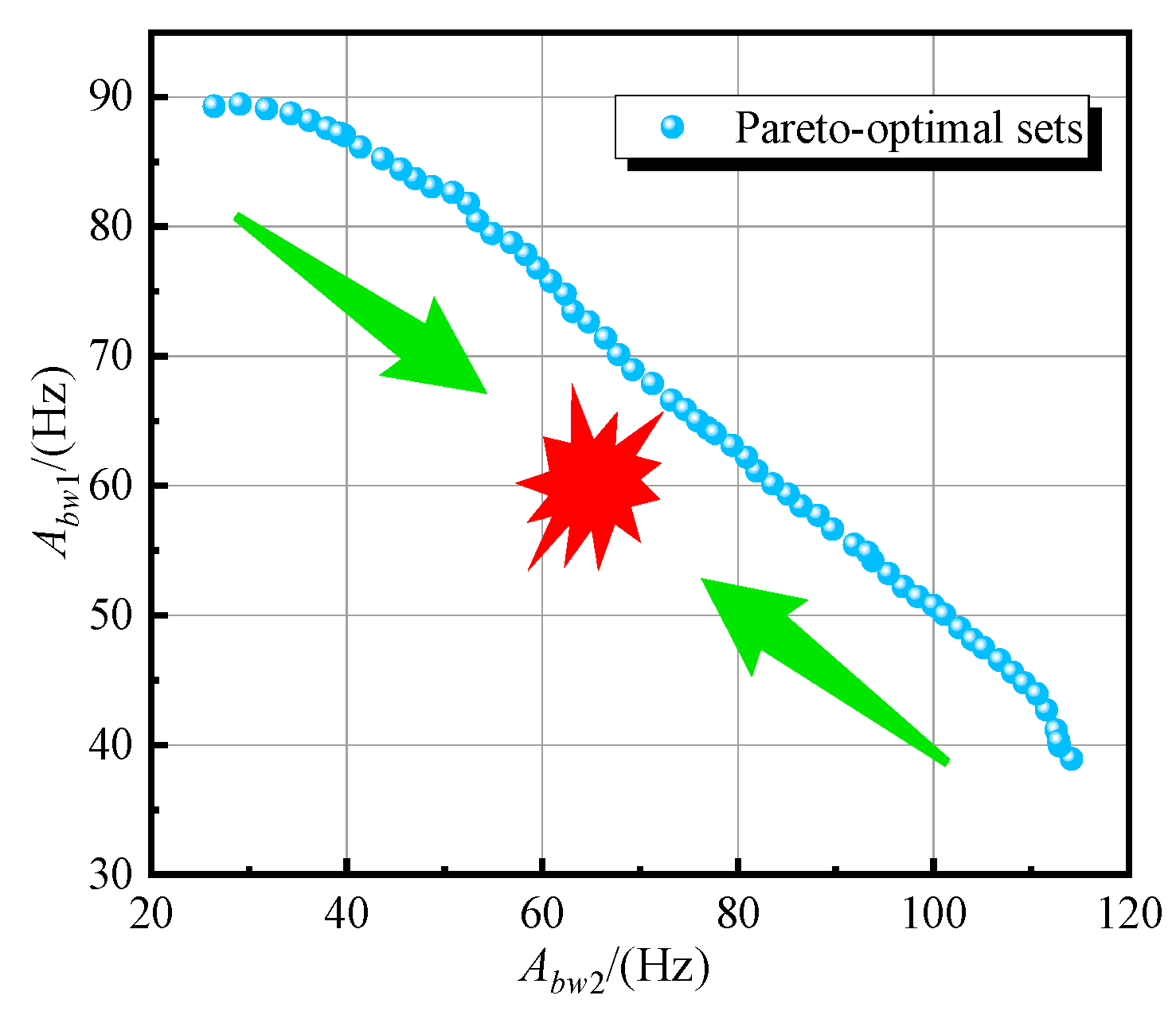
| Response | θ1(D) | θ2(r) | R2 | MAX |
|---|---|---|---|---|
| Abw1 | 1.2374 | 0.0040 | 0.99422 | 0.03993 |
| Abw2 | 1.0004 | 0.0065 | 0.99234 | 0.04548 |
| Variables | Initial Values | Optimized Values | Verification Values |
|---|---|---|---|
| D(mm) | 3 | 0.8 | 0.8 |
| r(mm) | 0.3 | 0.1 | 0.1 |
| Abw1 (Hz) | 34.55 | 111.41 | 111.26 |
| Abw2 (Hz) | 87.32 | 43.20 | 43.19 |
| Atotal (Hz) | 121.87 | 154.61 | 154.45 |
Disclaimer/Publisher’s Note: The statements, opinions and data contained in all publications are solely those of the individual author(s) and contributor(s) and not of MDPI and/or the editor(s). MDPI and/or the editor(s) disclaim responsibility for any injury to people or property resulting from any ideas, methods, instructions or products referred to in the content. |
© 2023 by the authors. Licensee MDPI, Basel, Switzerland. This article is an open access article distributed under the terms and conditions of the Creative Commons Attribution (CC BY) license (https://creativecommons.org/licenses/by/4.0/).
Share and Cite
Zou, Z.; Xu, F.; Pan, Y.; Niu, X.; Fang, T.; Zeng, C. Parametric Analysis and Multi-Objective Optimization of Pentamode Metamaterial. Sustainability 2023, 15, 3421. https://doi.org/10.3390/su15043421
Zou Z, Xu F, Pan Y, Niu X, Fang T, Zeng C. Parametric Analysis and Multi-Objective Optimization of Pentamode Metamaterial. Sustainability. 2023; 15(4):3421. https://doi.org/10.3390/su15043421
Chicago/Turabian StyleZou, Zhen, Fengxiang Xu, Yuxiong Pan, Xiaoqiang Niu, Tengyuan Fang, and Chao Zeng. 2023. "Parametric Analysis and Multi-Objective Optimization of Pentamode Metamaterial" Sustainability 15, no. 4: 3421. https://doi.org/10.3390/su15043421
APA StyleZou, Z., Xu, F., Pan, Y., Niu, X., Fang, T., & Zeng, C. (2023). Parametric Analysis and Multi-Objective Optimization of Pentamode Metamaterial. Sustainability, 15(4), 3421. https://doi.org/10.3390/su15043421







